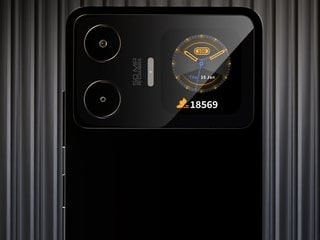- Home
- Mobiles
- Mobiles Reviews
- Realme GT Neo 3 (150W) Review: All About Speed?
Realme GT Neo 3 (150W) Review: All About Speed?
It charges very quickly and offers decent value, but misses out on a few things.

The Realme GT Neo 3 (150W) is priced at Rs. 42,999 in India
The Realme GT Neo 2 (Review) was a brand-new smartphone and the first to launch in the Neo series in India. Despite its lacklustre camera performance, it still made for an excellent mid-range gaming smartphone with its 800-series Snapdragon SoC, beefy cooling system and an attractive price tag which started at just Rs. 31,999.
Recently, Realme launched its successor called the GT Neo 3. It boasts of a better OIS-driven main camera and a new processor. There's also a special 150W fast charging model which is what we'll be reviewing today. Is the Realme GT Neo 3 (150W) a step forward for the GT Neo series and does it offer good value like its predecessor? It's time to find out how well it competes with the other premium smartphones in this segment.
Realme GT Neo 3 (150W) price in India
Realme's GT Neo 3 (150W) is priced at Rs. 42,999. This model has a 4,500mAh battery and comes with a 150W charger in the box. The 80W model of the phone features a 5,000mAh battery and ships with an 80W charger. This model is available in two variants, one with 8GB of RAM and 128GB of storage for Rs. 36,999 and the other with 8GB of RAM and 256GB of storage for Rs. 38,999. Both models are available in three colours, Asphalt Black, Nitro blue, and Spring White. The latter two have racing stripes on the rear panel while black variant has a plain finish, for those that don't want to attract too much attention.
Realme GT Neo 3 (150W) design
The Realme GT Neo 3 has a similar form to the GT Neo 2. Some of the changes include a new finish for the back panel, a different layout of the rear cameras, and a centred hole-punch cutout for the selfie camera. Realme has swapped the flashy dual-tone rear glass panel of the GT Neo 2 for a simpler matte-finished AG glass, which turned out to be a big fingerprint magnet.
![]()
The Realme GT Neo 3 (left) looks and feels very similar to the GT Neo 2 (right)
The GT Neo 3 sure feels a lot more premium than the OnePlus 10R, the Neo 3's twin that I reviewed earlier, and also has a nicer in-hand feel. At 188g, it's not too heavy but still isn't the ideal size for one-handed use. Its large display has Gorilla Glass 5 protection and does attract fingerprints, but these can be wiped off easily. The hole-punch AMOLED display has thin bezels all around, which adds to the premium look.
![]()
The Realme GT Neo 3 has a smooth matte-finished glass back which feels quite premium
The Realme GT Neo 3's mid-frame is made from polycarbonate. Just like the back panel, it too has a matte finish, which makes the phone quite slippery in the hand. Thankfully, Realme has included a tinted, transparent TPU case in the box, that offers plenty of grip and also lets you show off the striking design.
Realme GT Neo 3 specifications and software
The Realme GT Neo 3 uses a MediaTek Dimensity 8100 SoC. Realme has also included an imaging chipset in the phone called the Dedicated Display Processor, which according to the brand, should help achieve better gaming performance and reduce power consumption. Connectivity options include Wi-Fi 6, Bluetooth 5.3, NFC, a Type-C Port and support for the usual satellite navigation systems. The fingerprint reader is embedded in the display and it worked reliably.
Realme has done a good job of merging Android 12 and all of its Material You goodness with Realme UI. Realme UI 3.0 on the GT Neo 3 looks quite stock in appearance, with only slightly different looking icons compared to what you get on a Pixel phone. All of the Android 12 widgets worked as expected and the theming engine also changed the colour of the keyboard, widgets and other icons depending on the applied wallpaper. The Personalisation section in the Settings app looks very similar to the one found in OnePlus and Oppo smartphones and lets you customise the icon shapes, quick settings icons, accent colours and the system font.
![]()
The Realme GT Neo 3 runs Realme UI 3.0 which is based on Android 12
As with every Realme smartphone, there are plenty of preinstalled third-party apps. However, these did not get in the way of my software experience and could be uninstalled if needed. What did annoy me was the intermittent notifications from the Themes Store app about new wallpapers and themes.
Realme GT Neo 3 (150W) performance
The Realme GT Neo 3 has a 6.7-inch full-HD+ AMOLED display with a 120Hz refresh rate. The display got sufficiently bright when viewed under direct sunlight and content appeared sharp and legible. Colours looked very punchy in the default Vivid screen colour mode, but this could be tweaked. The refresh rate is adaptive but it only switches between 60Hz and 120Hz depending on the running app. While this worked fine when watching movies (at 60Hz) or browsing through the user interface (at 120Hz), the display was locked to 60Hz even in games that typically support 120Hz, which I found a bit disappointing.
![]()
The Realme GT Neo 3 offers a quality 120Hz AMOLED display
Also missing is an HDR10 video streaming certification for apps such as Netflix, but standard content looked sharp with decent black levels. The phone also has stereo speakers, which sounded loud and clear and made the video consumption and gaming experience quite immersive.
While the software performance of the Realme GT Neo 3 felt fluid and responsive, benchmark scores came close to smartphones running Qualcomm's Snapdragon 888 SoC. In AnTuTu, the phone scored 8,10,225 points. It also achieved 969 and 4,065 points in Geekbench's single and multi-core tests respectively. Graphics benchmarks is where the Dimensity 8100 SoC didn't get to stretch its legs, possibly due to the frame rate cap in games. The GT Neo 3 managed 54fps and 60fps in GFXBench's T-rex and Manhattan 3.1 gaming tests, where the Snapdragon 888-powered Xiaomi 11T Pro (Review) managed 121fps and 100fps.
Sadly, the weak graphics scores were not limited to synthetic benchmarks since real-world gaming performance was not great either, unless GT Mode was enabled. In regular mode, both Call of Duty: Mobile and Asphalt 9: Legends would stutter and skip frames when running at the high graphics settings, but ran better at medium settings. In GT Mode, these games ran better at the highest settings possible although it still wasn't as fluid or lag-free as I would have liked. Surprisingly, there was even a 60fps mode when playing Asphalt 9:Legends, which I've only noticed on Snapdragon-powered devices till now.
![]()
Games like Asphalt 9: Legends performed well provided the GT mode was switched on
Battery life was quite good. The Realme GT Neo 3 lasted for about a day and a half on a single charge, even with heavy gaming and camera usage. In our HD video loop test, the phone lasted for 19 hours and 26 minutes which was quite good for a premium smartphone.
The 150W charger managed to charge the phone from zero to a 100 percent in just 16 minutes, when using the Rapid charging mode. While this is one of the fastest charging speeds we have seen till date, the GT Neo 3 did get quite hot in the process which worried me a little. However, Realme claims that there are several safety measures in place to avoid any mishaps. Just like on the OnePlus 10R Endurance Edition, the GT Neo 3 also displays a pop-notification on the screen to warn you that the phone will get hot when using the Rapid charging mode.
Realme GT Neo 3 cameras
The primary camera on the Realme GT Neo 3 gets optical image stabilisation (OIS) and a higher-quality 50-megapixel Sony IMX766 sensor, compared to the 64-megapixel sensor on the GT Neo 2. There's an 8-megapixel ultra-wide-angle camera and a 2-megapixel macro camera, both of which have fixed-focus systems. A 16-megapixel front-facing camera is in charge of selfies and Realme has used a Samsung sensor this time with a slightly wider aperture and field of view compared to its predecessor.
![]()
The Realme GT Neo 3 has three rear cameras, one of which now comes with OIS
As a result, daylight performance from the main camera has surely improved over the GT Neo 2. Landscape photos were well exposed and had good dynamic range. Details in the images taken from the primary camera were good but the photos appeared a bit saturated, especially when compared to those taken from the ultra-wide camera.
The latter offers a wide 120-degree field of view, but these photos have comparatively limited dynamic range and objects appear blurry towards the edges of the frame. Close-ups of flowers taken with the primary camera came out sharp but looked quite saturated. The 2X digital zoom was also useful but such photos had slightly lesser detail.
Realme GT Neo 3 daylight camera samples: (Top to bottom) Ultra-wide-angle camera, primary camera, close-up from primary camera (tap to see full size)
Colours were handled better when using the phone's Portrait mode as it was a bit toned down and natural-looking in comparison. Edge detection was good and so was the dynamic range with well-exposed backgrounds. Selfies came out looking a bit oversharpened and saturated, with brighter backgrounds getting blown out. Switching to Portrait mode for selfies improved dynamic range drastically, but edge detection was strictly average. The macro camera captured average looking photos with noticeable purple fringing around the edges of objects but its fixed-focus system was annoying and difficult to use, more so than usual.
In low light, photos taken from the primary camera packed good detail and dynamic range. The camera automatically took longer exposures when needed in the Auto mode and these photos had equally good detail as the dedicated Night mode photos. Pictures shot with Night mode tended to brighten up the scene a bit too much and ended up overexposing the brighter areas. Selfies in low light did not look great and looked quite soft with weak details. Portrait mode selfies looked extremely noisy while Night mode selfies lacked good textures on subjects.
Realme GT Neo 3 low-light camera samples: (top) Night mode, (bottom) Low-light selfie portrait (tap to see full size)
The quality of recorded video was quite decent overall. Videos shot at 1080p in daylight looked fine but it did not have good enough detail. Videos shot in 4K had better details but with limited dynamic range. 4K videos were not stabilised well and appeared jerky. Using the AI highlight feature did improve the dynamic range, but videos were not as smooth or sharp as videos taken without it and the resolution was also limited to 1080p 30fps. In low light, videos recorded at 1080p had limited dynamic range and appeared soft. 4K 30fps footage looked the best, but again, lacked proper stabilisation.
While the image quality from the main camera is a solid improvement over the Realme GT Neo 2, it's worth noting that Realme has used this sensor in a much lower-priced phone too such as the Realme 9 Pro+ 5G (Review). As much as I liked the quality of the photos, it's far from what I've seen on competing devices such as iQoo's 9 SE (Review).
Verdict
I would agree with Realme that the GT Neo 3 (150W) is all about speed. There's the race car inspired design, 150W charging system, crisp 120Hz display and a processor that offers good performance. Its cameras have also received plenty of improvement over the GT Neo 2.
Unfortunately for the GT Neo 3, having more features does not translate to a very competitive smartphone. Despite its upgrades over its predecessor, the GT Neo 3 is only playing catch-up with the competition, unless you are comparing it with the OnePlus 10R Endurance Edition (Review), which is basically the same phone with a different design and name.
The Realme GT Neo 3's 150W fast charging system does make the phone worryingly hot and the display's 120Hz refresh rate isn't usable in most games that I tried. The SoC also falls a bit short in terms of raw performance compared to the competition, most of which pack a Qualcomm Snapdragon 888 SoC. Meanwhile, the phone also lacks a few hardware features like an IP rating or wireless charging, which are available on competing devices such as the Samsung Galaxy S20 FE 5G (Review) and the Apple iPhone (2022) (Review) in the similar priced range.
Even the regular 80W model of the Realme GT Neo 3 feels a bit expensive, since iQoo's 9 SE (Review) offers better core hardware and camera performance at a lower starting price. There's little reason to take the Realme GT Neo 3 (150W) seriously at its existing price, unless you are a Realme fan or simply crave the fastest charging speed currently available.
Catch the latest from the Consumer Electronics Show on Gadgets 360, at our CES 2026 hub.
Related Stories
- Samsung Galaxy Unpacked 2025
- ChatGPT
- Redmi Note 14 Pro+
- iPhone 16
- Apple Vision Pro
- Oneplus 12
- OnePlus Nord CE 3 Lite 5G
- iPhone 13
- Xiaomi 14 Pro
- Oppo Find N3
- Tecno Spark Go (2023)
- Realme V30
- Best Phones Under 25000
- Samsung Galaxy S24 Series
- Cryptocurrency
- iQoo 12
- Samsung Galaxy S24 Ultra
- Giottus
- Samsung Galaxy Z Flip 5
- Apple 'Scary Fast'
- Housefull 5
- GoPro Hero 12 Black Review
- Invincible Season 2
- JioGlass
- HD Ready TV
- Laptop Under 50000
- Smartwatch Under 10000
- Latest Mobile Phones
- Compare Phones
- OPPO A6c
- Samsung Galaxy A07 5G
- Vivo Y500i
- OnePlus Turbo 6V
- OnePlus Turbo 6
- Itel Zeno 20 Max
- OPPO Reno 15 Pro Mini 5G
- Poco M8 Pro 5G
- Lenovo Yoga Slim 7x (2025)
- Lenovo Yoga Slim 7a
- Realme Pad 3
- OPPO Pad Air 5
- Garmin Quatix 8 Pro
- NoiseFit Pro 6R
- Haier H5E Series
- Acerpure Nitro Z Series 100-inch QLED TV
- Asus ROG Ally
- Nintendo Switch Lite
- Haier 1.6 Ton 5 Star Inverter Split AC (HSU19G-MZAID5BN-INV)
- Haier 1.6 Ton 5 Star Inverter Split AC (HSU19G-MZAIM5BN-INV)


















